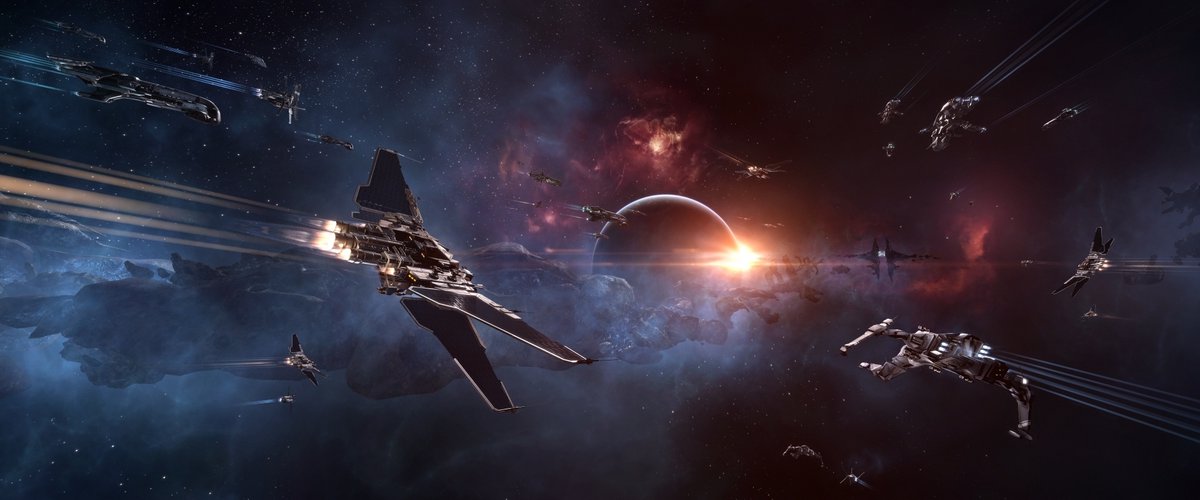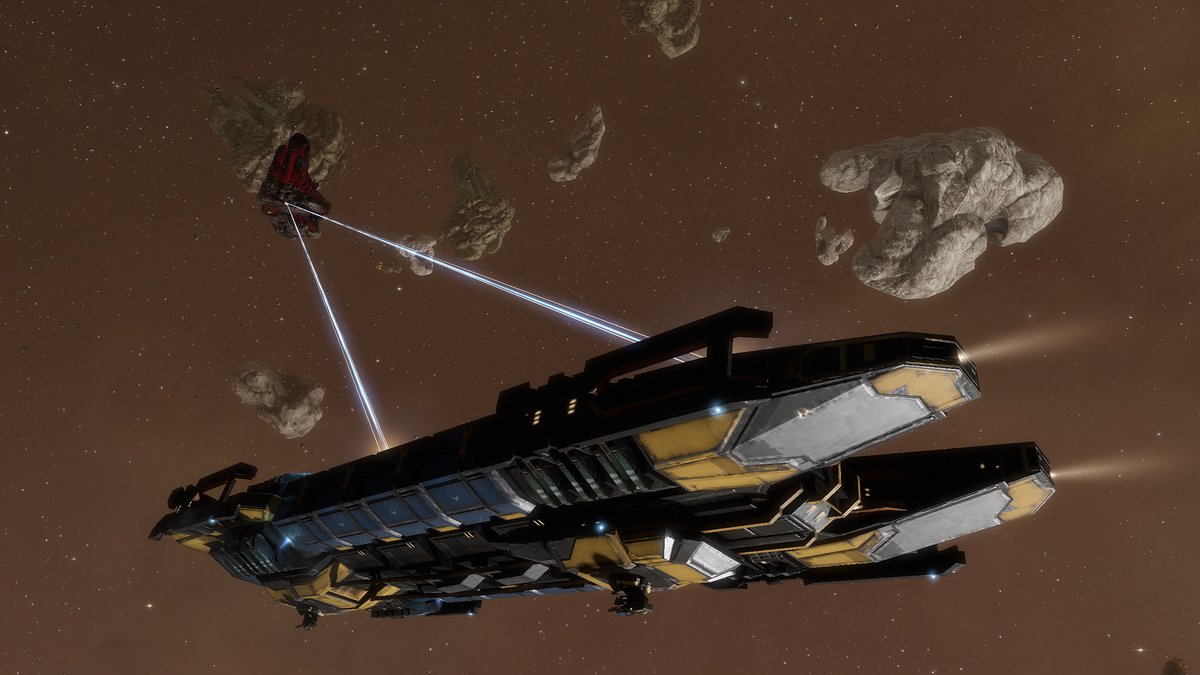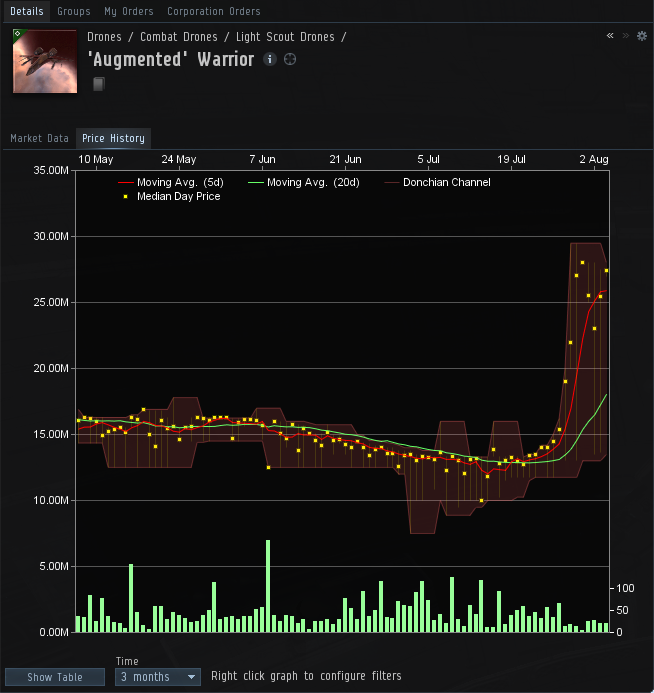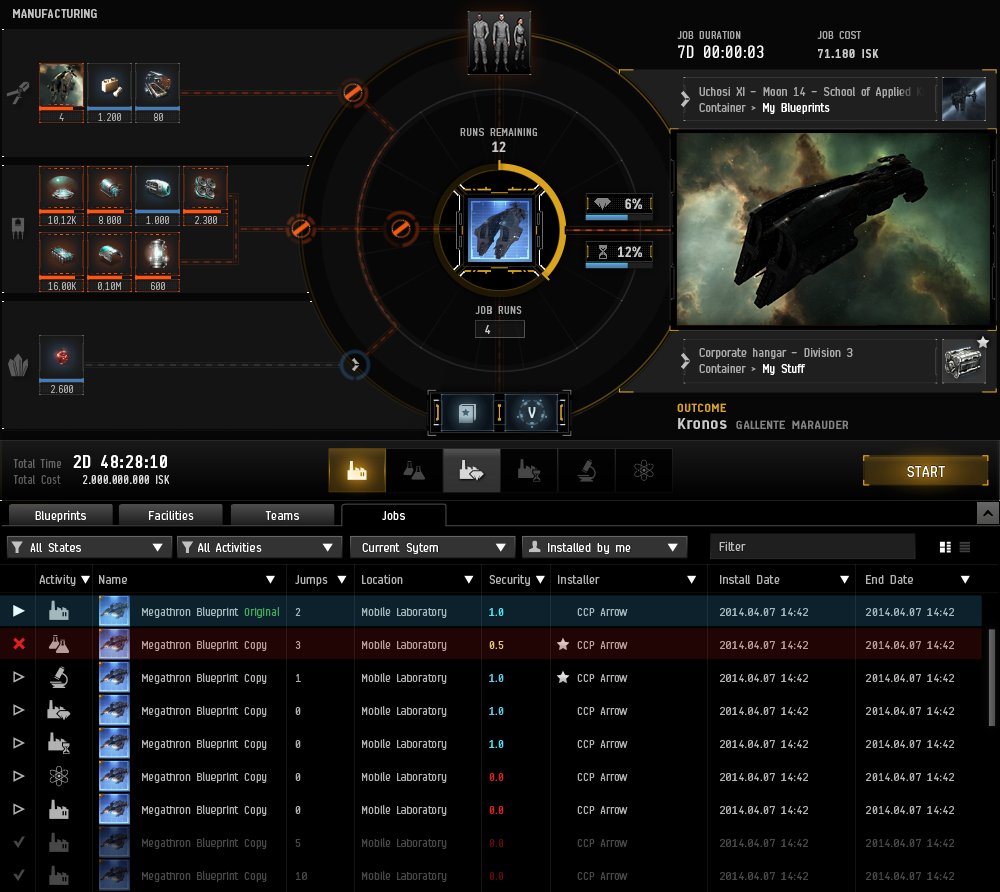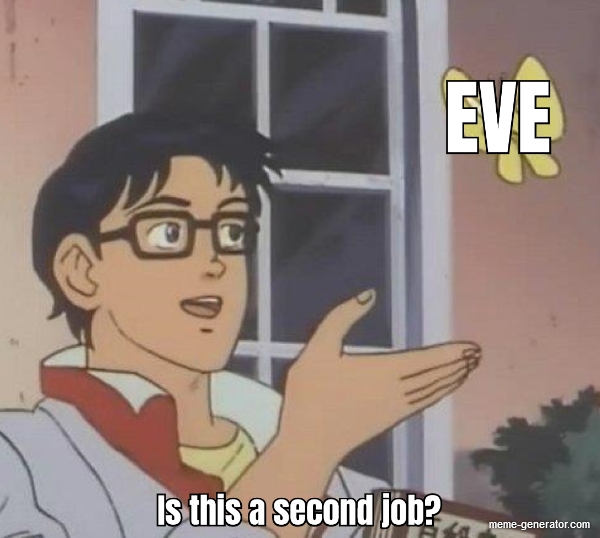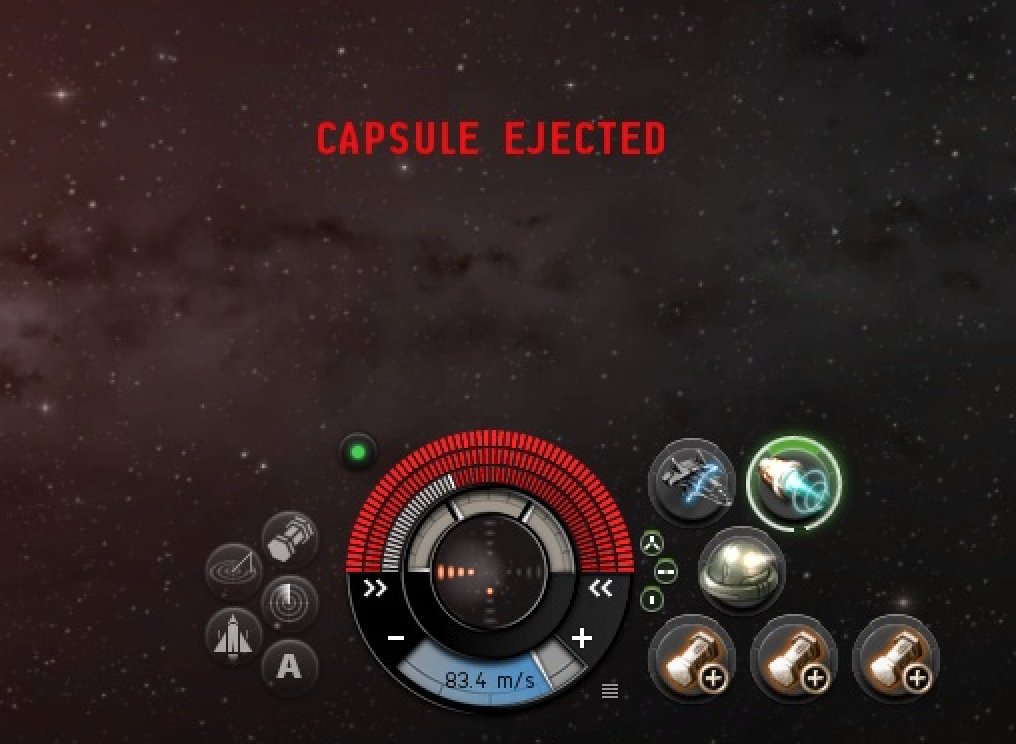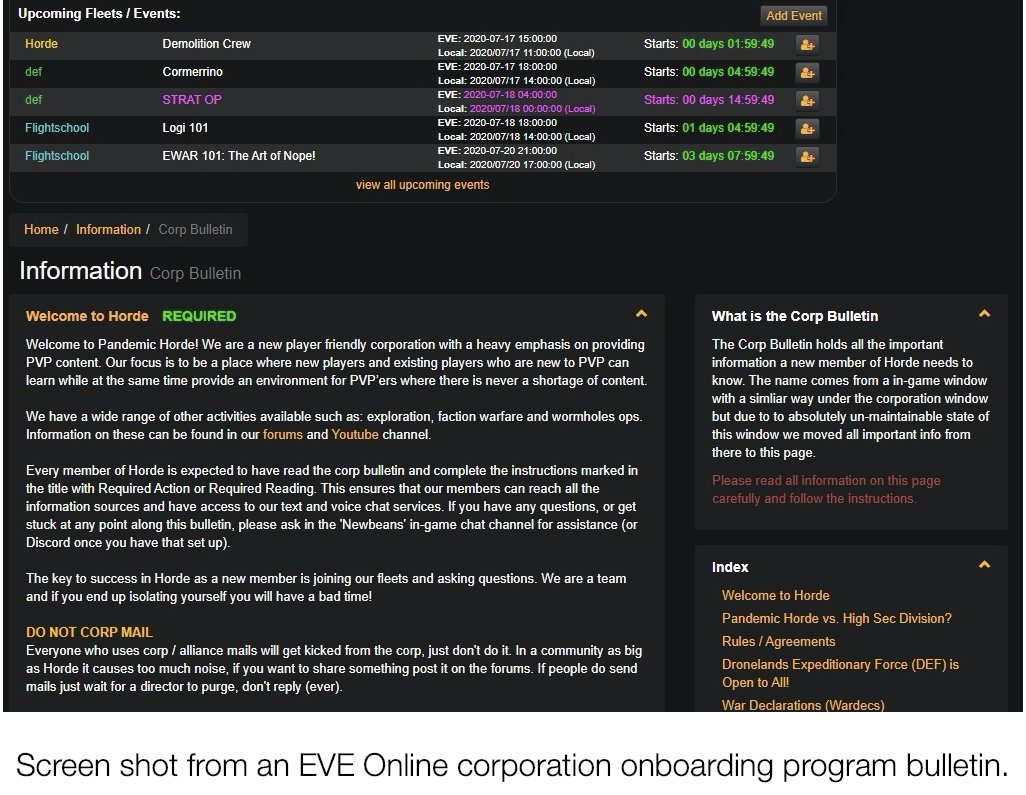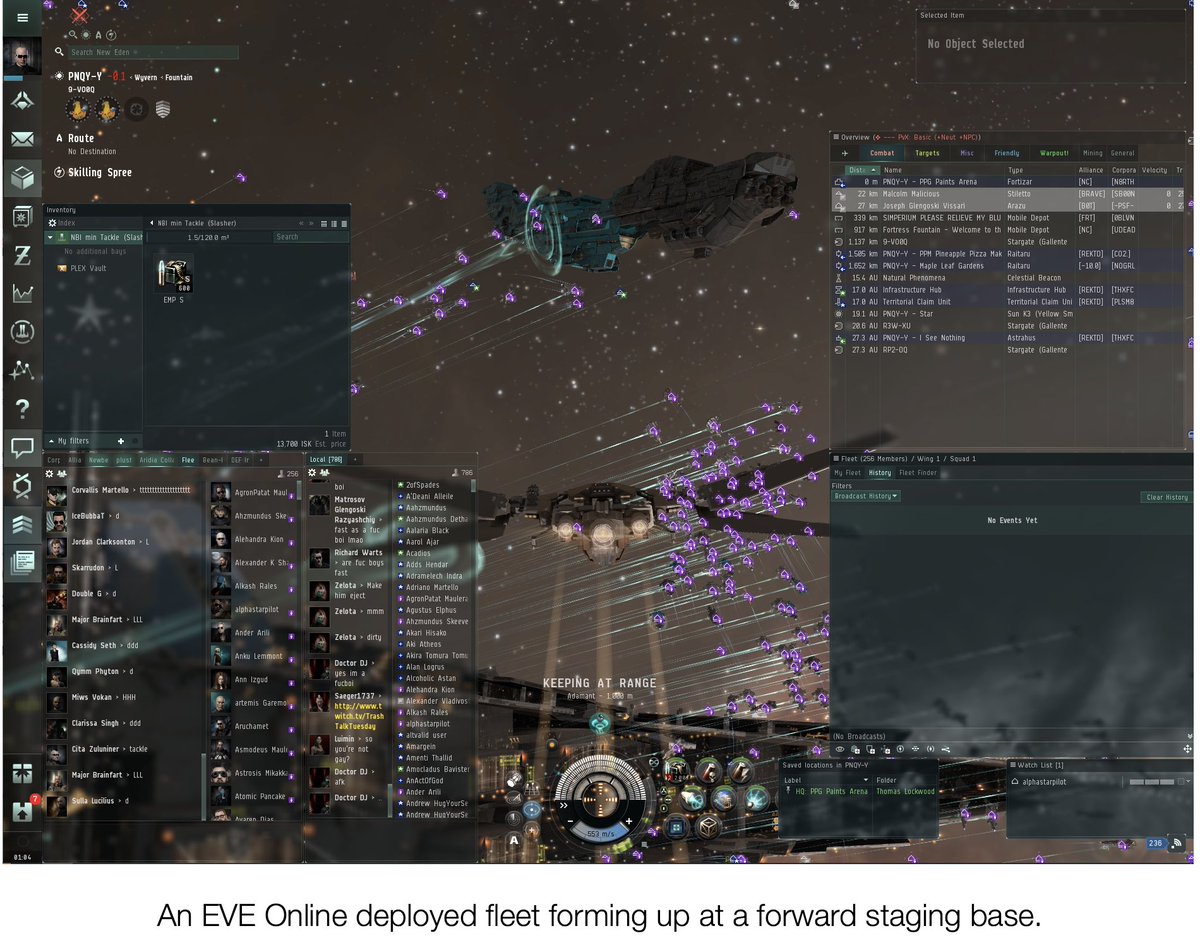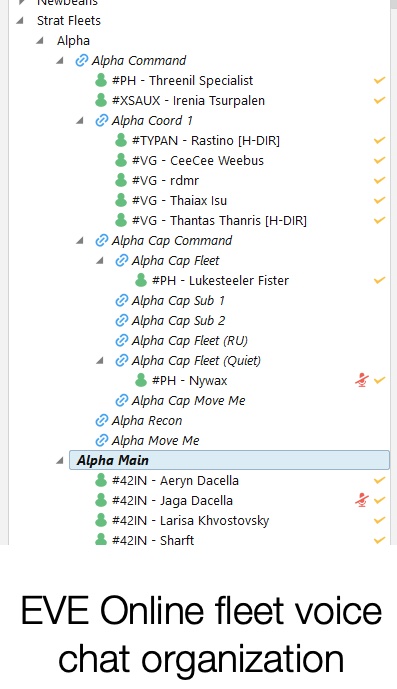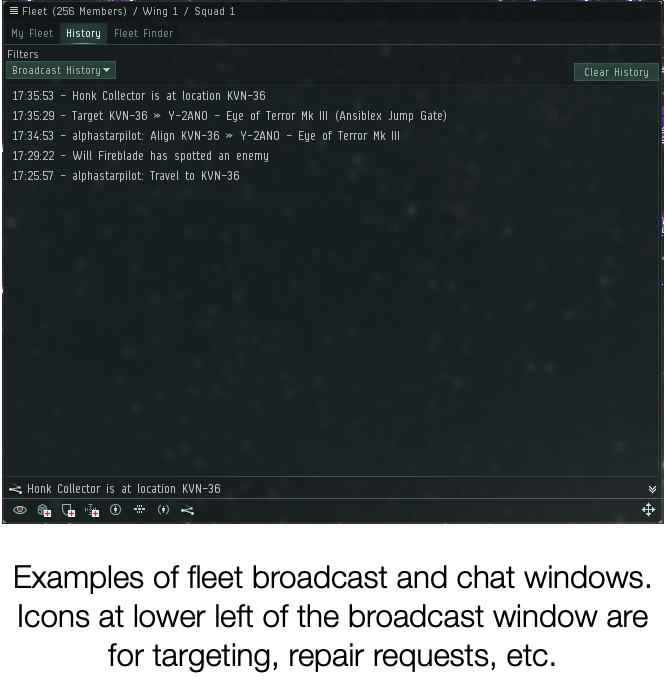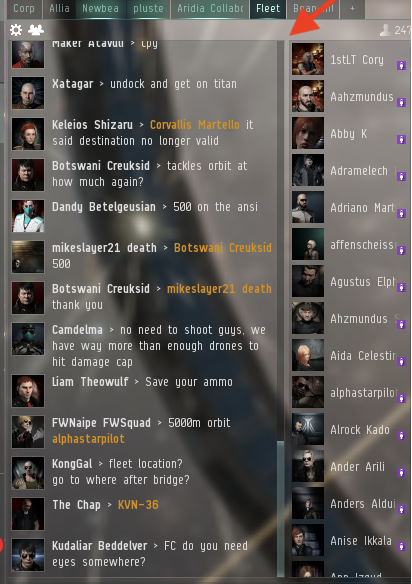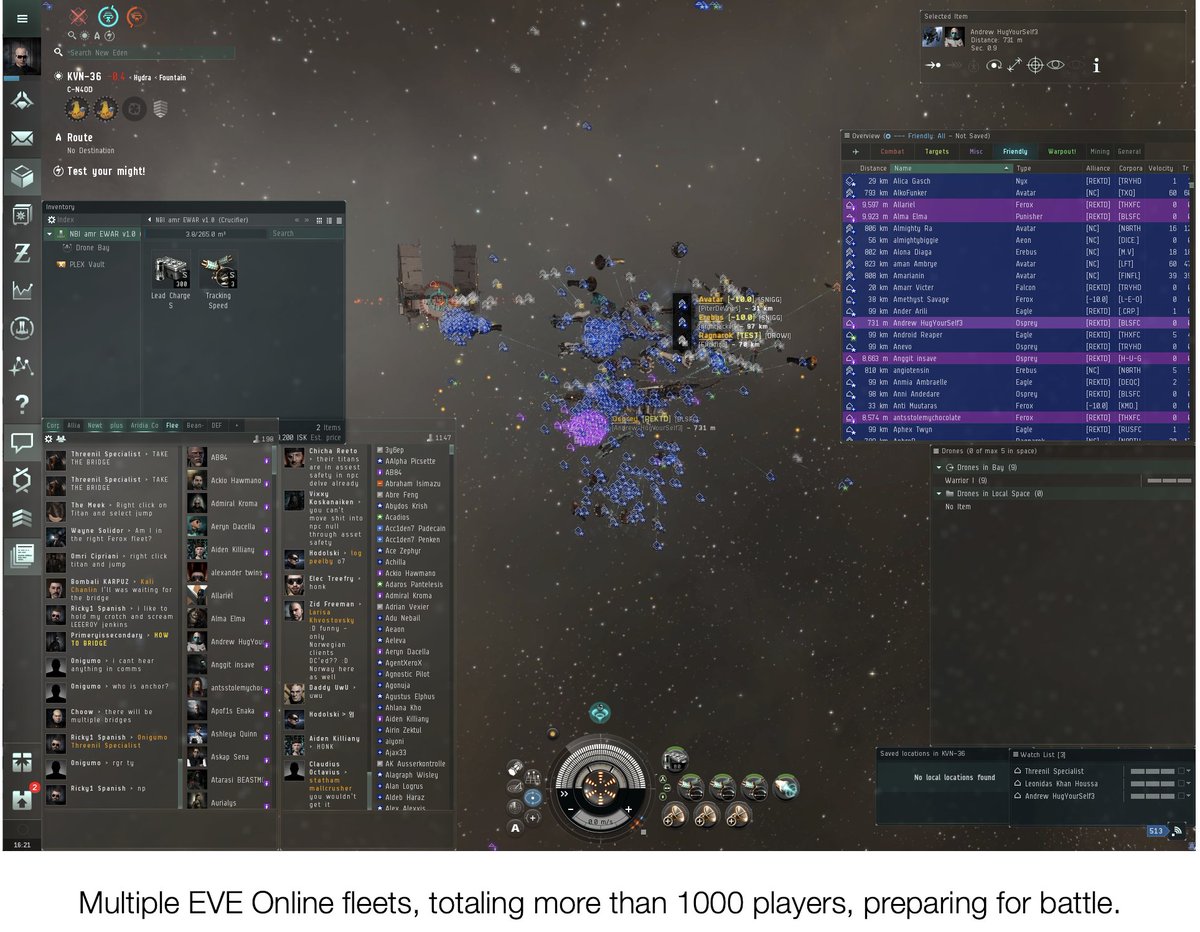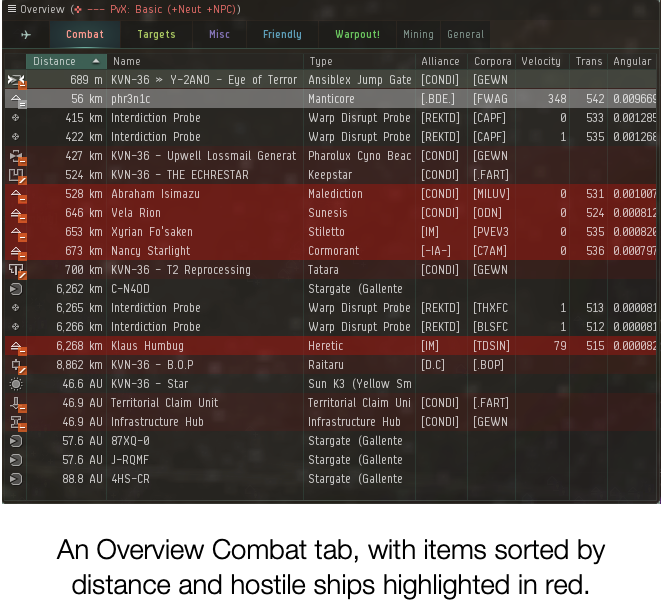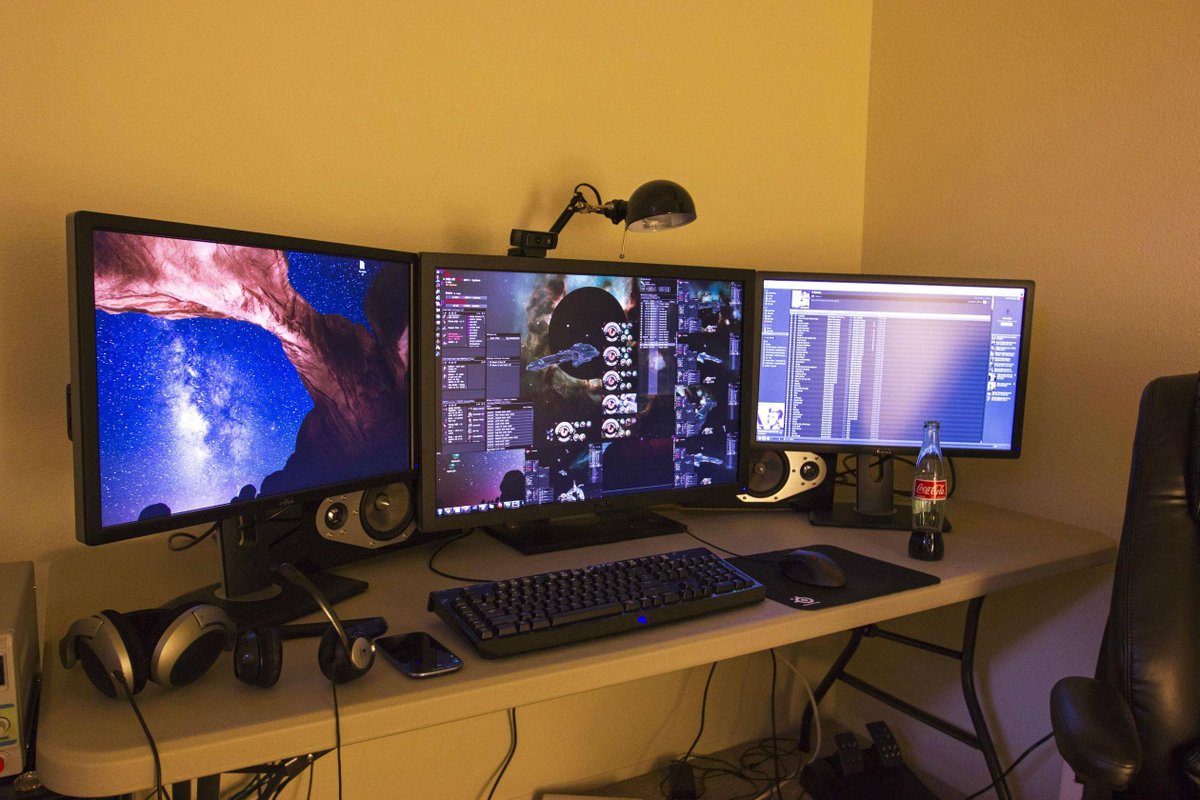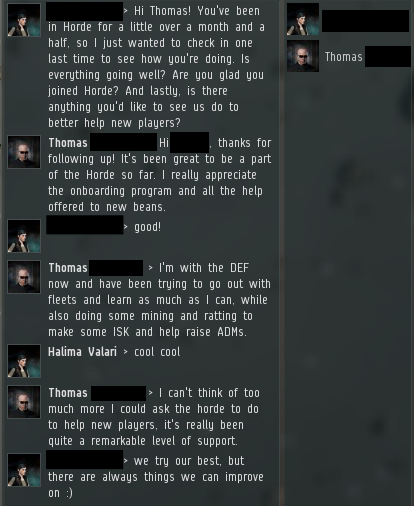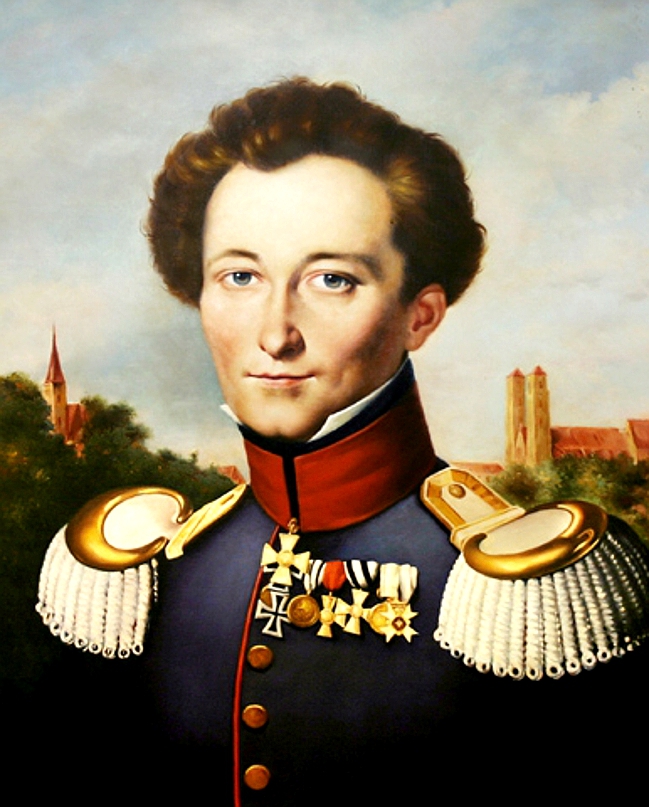Some Sunday fun:
The @EveOnline experience: what I observed participating in virtual fleet battles in one of the world& #39;s largest massively multiplayer online games - and what it could mean for defense thinkers.
Thread follows:
The @EveOnline experience: what I observed participating in virtual fleet battles in one of the world& #39;s largest massively multiplayer online games - and what it could mean for defense thinkers.
Thread follows:
For some time there& #39;s been DoD interest in looking at video games for inspiration & sources of innovation in defense technology. Anyone who& #39;s spent much time playing both modern games & using military tech knows that defense firms could sure learn plenty. https://www.wired.com/story/will-roper-pentagon-video-games/">https://www.wired.com/story/wil...
Not long after I started playing @EveOnline, a persistent-world massively multiplayer online role-playing game (MMORPG) focused on virtual spacefaring, it occurred to me that this was a platform from which DoD and defense thinkers could learn a lot. https://www.eveonline.com"> https://www.eveonline.com
First released in 2003, the game has about 7.5M subscribers; I& #39;ve seen typically about 30,000 logged in at most times. Many of the game’s players self-organize into groups known as corporations; with sizes ranging from dozens to thousands of players
The numbers and persistent nature of the game make for an ongoing arena where the continuous & merciless competition of virtual warfare has honed to a fine edge features such as distributed C2, highly effective graphical user interfaces (GUIs), & multilayered information warfare.
The observations I& #39;ll lay out here are derived from roughly 6 months playing EVE as part of a large player corporation, one that& #39;s engaged in an ongoing war as part of a formal alliance, as well as in an informal coalition with other player corporations.
EVE is centered mostly on flying virtual spaceships, and especially on combat between those spaceships. Combat can be either against computer-spawned enemies, known as player-vs-environment (PVE), or against ships flown by other human players, known as player-vs-player (PVP).
In larger-scale fleet combat, many of the virtual ships involved have specialized roles: logistics, repair, C2, electronic warfare, ISR, dedicated drone carriers, & ships that disable adversary ships’ propulsion, preventing escape ("tacklers").
Outside combat, other ships & players specialize in ops such as freight hauling, mining, exploration, & industrial production, etc., all in support of either their own online character or to provide the resources necessary to support the operations of their corporation.
EVE has a complex economic system based on an in-game currency known as Interstellar Kredits (ISK, the currency code of Iceland, where the game’s developers are). An open economy mostly run by players, it involves the mining / trade of natural resources...
...manufacturing of all sorts of ships, weapons, sensors and command modules, personal player enhancements (like cerebral implants or drugs), space stations, refineries, and more. Players have been known to joke that playing EVE is sometimes like having a second job.
The various star systems in EVE (there are more than 5K) are divided into three parts: high-security, low-security and null-security space. These differ from each other mostly in the level of protection provided to players who want to avoid combat against other human players.
In high-sec space, an unprovoked attack will cause law enforcement ships to appear which will attack the offending player. In low-sec space, protection also exists though only in limited areas, with players operating in open space at risk of attack. https://wiki.eveuniversity.org/System_security ">https://wiki.eveuniversity.org/System_se...
In null-sec space the game is essentially lawless, with any player free to attack any other w/out intervention. With piracy, espionage, bounty hunting, spies, and more quite common, among those in the online gaming community EVE is legendary for its complexity & remorselessness.
The game even has grief counselors available to help new players get past and learn from the mental adversity associated with losing ships to other players for the first time. https://www.pcgamer.com/eve-online-to-implement-grief-counselling-when-new-players-lose-their-first-ship/">https://www.pcgamer.com/eve-onlin...
It doesn& #39;t take long after getting started in EVE to realize that combat against other human players, most far more experienced & better-equipped, will continue to be a losing proposition for some time.
To accelerate learning & even up the odds, many new players will join player corporations. To do this, and to observe how teams operate in this virtual arena, I joined one of EVE’s largest corporations, one with more than 10,000 members, and itself part of a larger alliance.
On acceptance I was directed into my corp’s formal onboarding program, one that looks to be about as effective as many found in real-world military orgs. The process starts with hyperlinked instructions from the corp’s in-game bulletin, which then sends new pilots to...
...a dedicated corp web site containing pages of detailed instructions required to get started operating as part of the fleet. These instructions provide standardized guidance on C2 networks, fleet ops, logistics, intel reporting, alliance management, rules of engagement, etc.
They also provide hyperlinks for files to upload & import to ensure GUI sensor & screen configurations are set up properly for fleet ops. Some pages include .gif video animations of actual screen manipulations to show a new pilot exactly what button-pressing is required.
Other pages include links to 3rd-party apps to support out-game comms via voice & multi-platform (mobile/desktop) text notifications. Corp guidance has a distinct focus on standardization of info flow; members can be immediately kicked out for using unauthorized/improper means.
The corp also provides a “care package” of free ships & character skills to enable new players ("new beans") to start operating effectively right away. The corp’s web site provides dates and times for “Flightschool” fleets to meet up and go out with an instructor as a group.
It also provides other training via a dedicated YouTube channel, with numerous long videos available to walk a player through how to conduct operations the corporation’s way. https://www.youtube.com/channel/UCg1v_BeF07JbmyJg3_gY_CA/videos">https://www.youtube.com/channel/U...
On to virtual combat: shortly after I joined up, my corp deployed an expeditionary force many systems away in enemy territory to join in a campaign against a hostile alliance.
Dropping my measured training pace, I travelled to the group’s forward base to jump in, hoping to gain an opportunity to see how all-out virtual fleet combat works. The trip didn& #39;t disappoint, as I& #39;ve been able to observe up-close months of non-stop large-scale campaigning...
...including world record-setting fleet battles (the largest multiplayer videogame player-vs-player battles). https://www.guinnessworldrecords.com/news/2020/10/eve-onlines-record-breaking-fury-at-fwst-8">https://www.guinnessworldrecords.com/news/2020...
The elements of the campaign have covered a wide spectrum of ops: commerce raiding, convoy escort, on-call defensive standing fleets, larger fleet ops to destroy enemy infrastructure, and truly massive fleets to support the invasion of enemy-held territory.
Larger fleet ops to support specific goals are known as STRATOPs (strategic operations). For players’ planning purposes, they are usually advertised ahead of time on the corp’s web site, with color coding indicating the magnitude & importance of the op.
Last-minute reminders w/ specific joining instructions (“pings”) go out via 3rd-party apps to desktop & mobile devices just commencement. These instructions include the name of the Fleet Commander (FC) to join, designated voice & chat comms channels, & required ship configs.
Fleet C2 is executed via multiple means. Members join voice comms via designated 3rd-party app & server, w/ a backup server pre-designated. While an FC talks outward to the entire fleet, channels are further divided into subgroups for command, logistics, main battle line, etc.
Keyboard push-to-talk shortcuts allow pilots to either “whisper” to only to their smaller group, or “shout” to the entire fleet in the event they learn vital information that needs to be heard by all, and up to the FC.
Another means C2 is via a fleet “broadcast” window, through which an FC can issue commands via discrete clicks to designate primary / secondary targets, warp the fleet in formation to a location, designate an intended route of travel, etc.
Players can use the broadcast window, also through single icon clicks, to transmit sightings, request repairs, or report their location, without any exchange of voice / text comms. When time allows, commands within the broadcast window are backed up by parallel voice commands.
The corp’s SOPs also include the use of text chat for more involved discussion or questions by fleet/corp members. Individual channels are kept permanently open for deployed force coordination, general corporate chat and discussion, and intelligence reporting.
On joining a fleet, a fleet chat window will also pop up. This is used for line fleet members to ask questions w/out breaking into voice comms; those questions are usually answered either by other fleet members via chat, or by the fleet commander via voice to ensure alignment.
During the largest fleet ops, the alliance will form multiple fleets (the limit is 256 ships for each), with the hardest-hitting ships often constituting the 1st fleet and smaller or more varied ships constituting secondary / tertiary (or more) fleets operating in support roles.
In the case of fleet engagements lasting several hours (I& #39;ve seen > 12) as fleet pilots start to lose ships, reinforcing detachments will form up at staging bases and make their back, either breaking up to join fleets upon arrival or entering the fight as an additional group.
These reinforcements are supported by additional notifications that go out to corporation members (in the real world, via text notifications), encouraging them to log in and join the fight if more reinforcements are needed.
Virtual island hopping:
At a higher level, after several months of my alliance’s campaign has in some ways reminded me of the island-hopping campaigns of the Pacific theater in WW2.
At a higher level, after several months of my alliance’s campaign has in some ways reminded me of the island-hopping campaigns of the Pacific theater in WW2.
Rather than stop & destroy every enemy facility in each system during the push to their home system, we& #39;ll typically jump several star systems ahead, using the mobility afforded by capital ships to establish new expeditionary bases.
Often the fight associated with establishing a new base is itself part of the objective, with a goal of pressuring the enemy fleet by forcing them to either come out and fight (and thus expend industrial resources) or lose territory.
Once a new base is established & the expeditionary force moves on, bypassed systems largely die on the vine. From the new base, alliance forces will sortie out to begin destroying regional enemy infrastructure in the region, setting conditions for moving on to the next system.
While all this is going on, other alliance members work on more mundane tasks to support the expeditionary force’s deployment: transporting ships, munitions, fuel, sensor and weapon modules, etc., either alone or in convoy; mining and refining specific raw materials, etc.
One rumor I heard re supply sources was that our adversaries actively engage in measures to compromise supply chains, selling ships to our members that are subtly misconfigured, reducing our fleets’ effectiveness in combat, while also reducing trust in our logistical base.
Some takeaways:
As discussed above, part of my goal in observing large-scale virtual combat (other than to play a fun & challenging game) was to see if there might be lessons learned (or confirmed) that could help to inform the conduct of real-world warfare in the 21st century.
As discussed above, part of my goal in observing large-scale virtual combat (other than to play a fun & challenging game) was to see if there might be lessons learned (or confirmed) that could help to inform the conduct of real-world warfare in the 21st century.
Given that the last major real-world fleet combat occurred 75+ yrs ago, and that large-scale combat b/w RPVs has yet to occur, the remorselessly competitive crucible of an MMORPG like EVE might be a good place to find/test interesting ideas - novel or otherwise.
Information in warfare:
One area of real-world focus that seems validated in virtual fleet warfare is the centrality of information to combat success. Whether seen in the flexible & dynamic C2 constructs described above, or in the attention paid to obtaining key information ...
One area of real-world focus that seems validated in virtual fleet warfare is the centrality of information to combat success. Whether seen in the flexible & dynamic C2 constructs described above, or in the attention paid to obtaining key information ...
...(and denying it to adversaries), maintaining an info advantage is routinely a key to victory in virtual warfare. FCs use tools such as stealthy ISR ships, disguised “neutral” ships really under their control, and spy networks within enemy C2 to maintain an info advantage.
An awareness of near-certainty of spying from w/in a corp’s own ranks also colors the nature of fleet C2, with info about valuable fleet assets held at higher levels and conducted via separate comms circuits - higher than would be accessed by a new-ish member such as me.
For example, I once saw a small fleet of mine get diverted to protect the emplacement of a vital new base. All involved (incl. the FC) were surprised by the op, which had been kept under the tightest secrecy in the hope of completing it under the cover of ad hoc fleet protection.
A key aspect of info within the EVE universe is the mgmt of real-time presentation. Particularly in a large fleet engagement, a player could be presented with an unmanageable flood of information to include thousands of items within a single solar system...
...friendly, enemy, & neutral ships; planets, asteroids, & celestial bodies; space stations, stargates, & other man-made structures.
To help present info in a useful form, the std EVE GUI provides default tabs & sorting mechanisms to bin and prioritize.
To help present info in a useful form, the std EVE GUI provides default tabs & sorting mechanisms to bin and prioritize.
These settings have been further customized for corp use; finely tuned through years of combat & competition, th& #39;ve been standardized & promulgated to all fleet pilots to ensure consistency in combat.
In an info “Overview”, pilots can sort info into situationally-appropriate tabs for traveling or combat, to quickly select a designated friendly ship to approach, or to warp to a random celestial body to quickly scatter at a moment’s notice (executed by an order to “starburst”).
Depending on an FC& #39;s direction, pilots can sort targets by distance, engaging the closest; or can sort by name and either focus on specific designated enemies or randomly select others by alpha order to spread of effects over an enemy fleet.
Std color coding allows pilots to quickly discern which ships are enemies or neutrals, or members of one& #39;s own corp, alliance, or fleet. This provides a corresponding combat terminology useful for classifying other player pilots as Red, Blue, Gray, or even "Bluetral" (coalition).
Perhaps most interestingly in an era of increased real-world focus by great power competitors on disruption of info and the facilities that distribute it, the C2 construct I& #39;ve seen operating here provides a potential new model for distributed C2, particularly of RPVs.
In ways perhaps analogous to those intended for greater distribution of combat forces in the era of precision strike, this C2 model consists of hundreds of operators logging in on unremarkable computers located at many locations, providing a way to reduce the vulnerability of C2.
Assuming that servers supporting these C2 functions were also distributed, no longer could an adversary cripple C2 by striking, kinetically or by other means, a single (or a few) fixed headquarters, or by executing a cyber attack to deny one type of standardized computer.
C2 functions could potentially hide within the clutter of civilian systems & ISPs, with operators logging in from locations distributed throughout the country - or the world.
Disclaimer: I AM NOT A CYBER EXPERT.
Disclaimer: I AM NOT A CYBER EXPERT.
A hybrid training model:
A common drive w/in defense training establishments in recent decades has been reducing training costs by pushing training to computer-based delivery, closing or down-sizing traditional training establishments to save on capital & personnel costs.
A common drive w/in defense training establishments in recent decades has been reducing training costs by pushing training to computer-based delivery, closing or down-sizing traditional training establishments to save on capital & personnel costs.
These efforts have mixed results, most visibly in the singling out of the Navy’s elimination of Surface Warfare Officer School (SWOS) in favor of computer-based training as a potential contributing factor in the warship collisions of recent years. https://www.navytimes.com/news/your-navy/2017/08/27/navy-swos-a-culture-in-crisis/">https://www.navytimes.com/news/your...
One model of training that I& #39;ve seen in EVE is a hybrid of on-line study & virtual - but individual - interaction. The corp I belong to is known for being newbie-friendly, relying on large numbers of decently-competent new pilots to swarm & overwhelm the fleets of others.
A crucial ingredient to the group’s success has been a comprehensive training program that can rapidly train players to a reasonably consistent standard of competence. All the while this training program must remain flexible & accessible enough to serve corp members...
... (who are all unpaid volunteers, as are their instructors) hailing from many demographic, personal, and national backgrounds, across multiple time zones and often with English as a second language.
It bears considering this training program isn& #39;t a product of traditional bureaucracy, nor is it stuck in defense establishment peacetime inertia; it& #39;s been continuously honed by training outcomes quickly judged by the harsh reality of constant & unending virtual team combat.
The model that& #39;s resulted is a multilayered one that includes features such as online reading assignments & training videos, team interactive training, extensive feedback & follow-up, and near-ubiquitous online access to instructors and experienced pilots.
Here& #39;s an example:
This flexible blend of virtual & personal training provided an effective and efficient means of rapidly training a group of new pilots on an important fleet role (which I used in combat the very next day).
This flexible blend of virtual & personal training provided an effective and efficient means of rapidly training a group of new pilots on an important fleet role (which I used in combat the very next day).
In contrast to sometimes-inflexible military computer-based training, a key feature is near-continuous access to instructors. In the game, duty instructors are available in a dedicated chat channel, so new players w/ questions can, at almost any time, get the help they need.
During fleet engagements, within fleet voice comms a dedicated voice cell is normally set up with an experienced instructor available for newer fleet members. At the conclusion of the fleet op the instructor will often provide a feedback form for new pilots to complete.
This construct, developed organically over years of combat, helps to allay one of the most timeless challenges of military operations: how to integrate new recruits into combat operations without leaving them ineffective or subject to excess attrition due to a lack of experience.
On a longer-term basis, instructors routinely reach out to newer pilots to check how they are doing, offering help & answering any questions the new pilot may have; as examples, I had the same instructor reach out to me at about the two week and one month points of my time.
The Safety of Hegemony vs Regional Spheres of Influence?
As the real world faces a potential transition from worldwide U.S. maritime primacy to spheres of influence in the Indo-Pacific, a *potential* parallel between the various regions in the EVE universe may be instructive.
As the real world faces a potential transition from worldwide U.S. maritime primacy to spheres of influence in the Indo-Pacific, a *potential* parallel between the various regions in the EVE universe may be instructive.
As mentioned above, in EVE’s high-security space a virtual hegemon provides some degree of safety to players who wish to avoid combat while operating in the commons. This force has, by design, complete escalation dominance against any human players who break the rules.
What this means is that while piracy does occur, it& #39;s relatively rare; fights between players occur under controlled conditions, and some mass effect weapons are unable to be used. As a result of these restraints, trade within high security space is fairly robust...
...markets are generally competitive, resources for manufacturing are freely available & transport is fairly inexpensive & regular. The parallel this provides to the modern liberal international order, with its Pax Americana supported by the USN, should be fairly obvious.
In stark contrast, the portion of the EVE universe within null-security space, which lacks the presence of a hegemon and keeper of the peace, is a universe consisting of clear spheres of interest, governed somewhat by corporate diplomacy but mostly by military capability.
The ability for ships (& trade) to pass through a given region is governed by which alliance or corp enjoys de facto control, what policies they choose to enforce, which entities are hostile, and whether a pilot has the skills & equipment to avoid being caught and overpowered.
As a result, trade in null-security space is fairly mercantilist, with sources of supply relatively limited, prices high, & buyers for merchandise mostly those that can safely transport to high-security markets for further sale. Let& #39;s hope this isn& #39;t like our real-world future.
Degrees of relevance:
To be sure, EVE is not the real world, which may in some ways limit the utility of lessons taken from the dynamics of its universe.
To be sure, EVE is not the real world, which may in some ways limit the utility of lessons taken from the dynamics of its universe.
First, some might point to the fact that the stakes are low, consisting merely of lost pixels and virtual currency, rather than real world blood and treasure. To this I can fairly answer that, while the ships in EVE are virtual, the emotions are often quite real.
Many of the those I& #39;ve encountered in the EVE universe are more invested & motivated about what they& #39;re doing within it than a fair portion of the actual military personnel, of multiple services, that I& #39;ve encountered over the years (w/ the obvious exception of the Marines).
Some folks might point out that the dynamics of computer-generated spaceships, and warfare between them, bear little relation to the complexity & mechanics of actual weapon systems. True enough.
But I& #39;d point out many defense thinkers are happy to point to lessons learned...
But I& #39;d point out many defense thinkers are happy to point to lessons learned...
...from 18th-century wooden sailing ships, or Napoleonic land battles, or perhaps combined arms campaigns in Ancient Greece, as sources of truth for modern battles involving electronic warfare, rail guns, and missiles (all of which are simulated within EVE to some degree).
Anyways, if you& #39;re a defense thinker & looking for new ideas, I recommend taking a look.
Just remember: if you wander into null-sec space & don’t show up as Blue, we& #39;ll be waiting to warmly welcome you! Don’t worry though, grief counselors are standing by...
Fin.
(whew!)
Just remember: if you wander into null-sec space & don’t show up as Blue, we& #39;ll be waiting to warmly welcome you! Don’t worry though, grief counselors are standing by...
Fin.
(whew!)
One more thing: if you& #39;re thinking that someone ought to write a book about EVE, you& #39;re in luck because someone already did. Lots of interesting stuff in here - balancing, bandwagoning, intrigue, palace coups, truly Machiavellian stuff. A good read. https://www.amazon.com/dp/B01DONPR0M/ref=dp-kindle-redirect?_encoding=UTF8&btkr=1">https://www.amazon.com/dp/B01DON...

 Read on Twitter
Read on Twitter